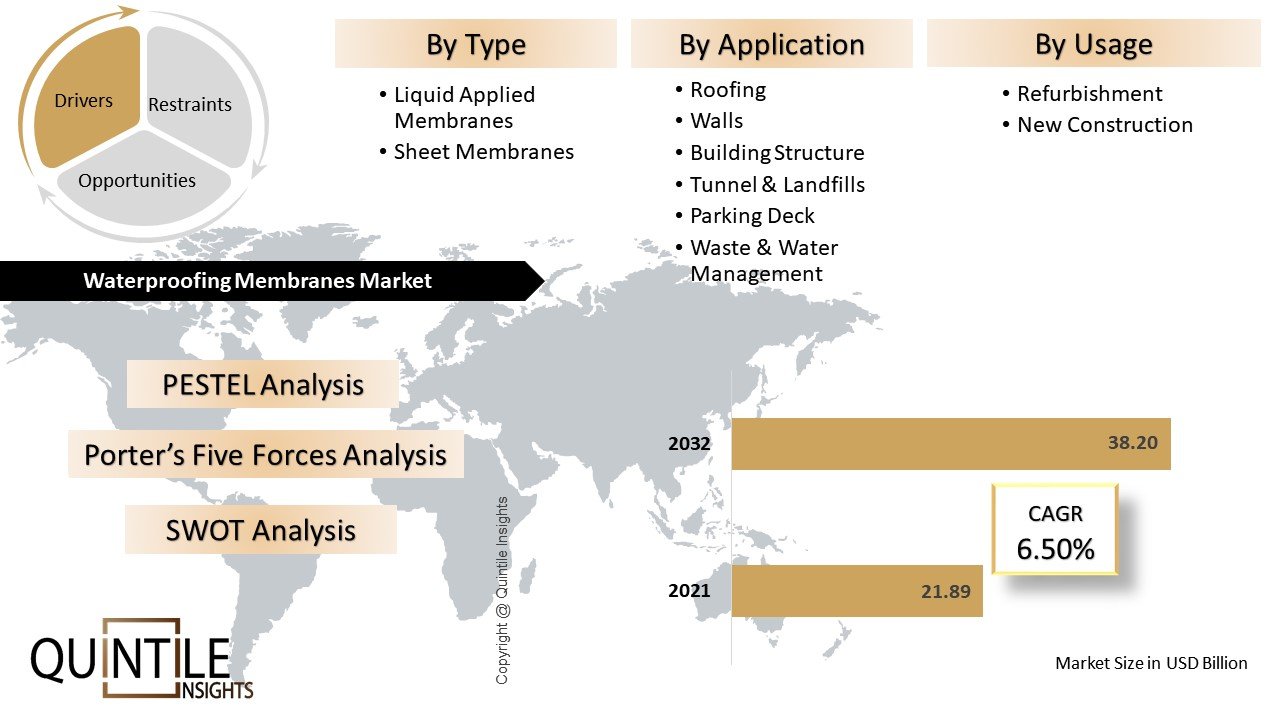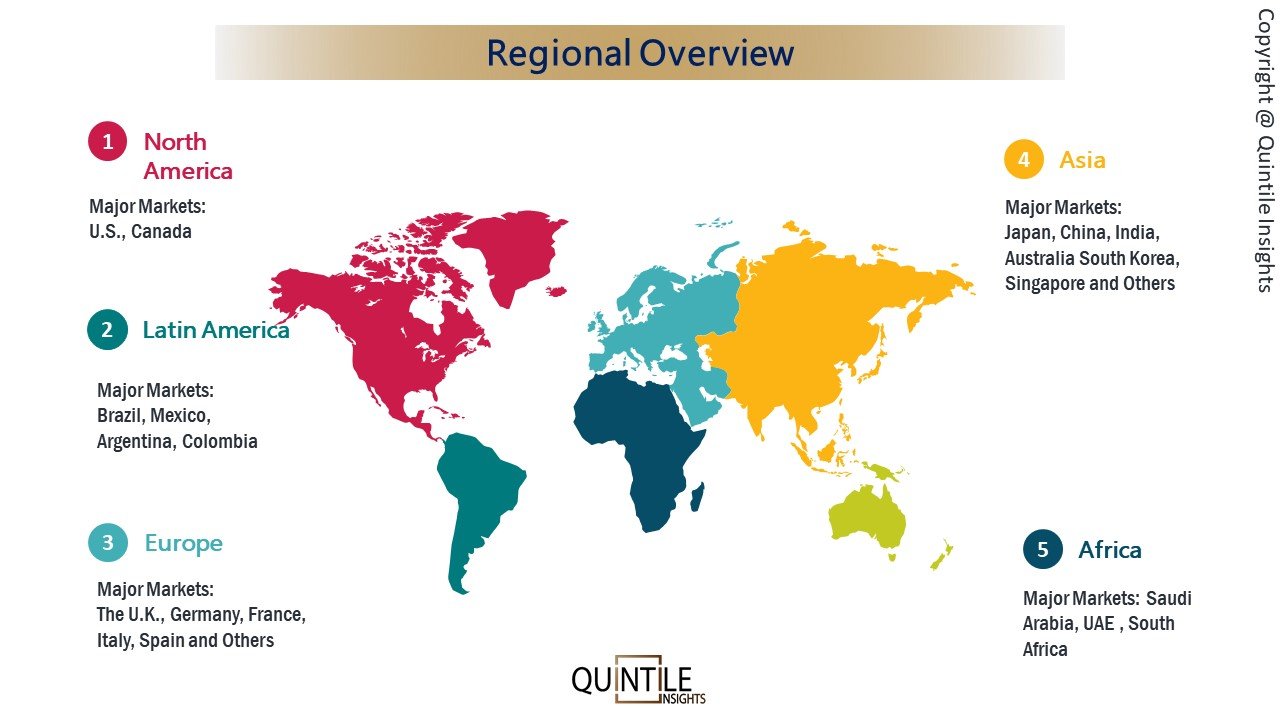MARKET SUMMARY
The global waterproofing membrane market was valued
at USD 21.89 billion in 2021 and it is predicted to rise at
a compound annual growth rate (CAGR) of 6.36% from 2022 to 2032. Waterproofing
membranes are utilized in wet rooms, roofs, water, sewage treatment facilities,
retaining walls, building foundations, and tunnels. The need for waterproofing
membranes is being fuelled by economic expansion, rising urbanization, and
industrialization in emerging economies, as well as increased infrastructure
investments. Product demand is expected to rise over the projection period,
thanks to increased consumer awareness of product benefits and the adoption of
new materials such as geomembranes.
A geomembrane is a synthetic membrane liner or
barrier with a very low permeability that is used with any geotechnical
engineering material to regulate fluid (liquid or gas) migration in a
human-made project, structure, or system. Geotextiles can be impregnated with
asphalt, elastomer, or polymer sprays, or as multilayered bitumen
geocomposites. Waterproofing technology is purely based on the same.
“Growing Prevalence of Infrastructure
Globally Fuels the Market”
Covid-19 has adversely affected the construction industry and its direct impacts have been felt severely on the waterproofing membrane. Following the end of the crisis, the market is expected to recover, and demand for waterproofing membranes has been predicted to rise. Demand for the infrastructure industry is expected to boom in the near future and thus booming the waterproofing market.

SEGMENT OUTLOOK:
The global waterproofing market is segmented based
on type, application, and usage.
Based on
type, the
waterproofing membrane market is segmented into liquid-applied membranes and
sheet membranes. In 2021, the liquid-applied membrane product segment dominated
the waterproofing membranes market. The increase can be ascribed to increased
awareness of the product's benefits, such as cost-effectiveness and convenience
of installation. In addition, as a global infrastructure for water conservation
and treatment improves, demand for liquid-applied membranes is likely to rise
in the future years. During the projected period, revenue for polyurethane
liquid applied membrane is expected to expand at a substantial rate of 8.8%. It
has a consistent thickness, making it convenient to use in a variety of
applications. These membranes are commonly used for roof waterproofing, moist
rooms, and water & sewage systems.
Demand for bituminous liquid membranes is estimated
to grow at a stable CAGR in terms of volume over the forecast period due to their
unique qualities such as high resistance to weathering and aging. It improves
the product's viability in terms of low-temperature flexibility, high UV
resistance, and better flow resistance at high temperatures. Due to product
characteristics such as UV radiation and precipitation resistance, polyvinyl
chloride (PVC) membrane is predicted to acquire a significant market share in
2022 and is likely to register a significant share over the forecast period.
Furthermore, the product's ability to bear big loads is projected to boost
market growth possibilities.
Based on
Application, the waterproofing membrane market is segmented
into roofing, walls, building structures, tunnel & landfills, parking decks,
and waste & water management. The roofing application category dominated
the waterproofing membranes market in 2021. The increase can be linked to its
increasing use in residential home construction in the Asia Pacific area. In
addition, the roofing segment is predicted to be driven by demand for sheet
membranes for roofs due to increased exposure to rainwater and environmental
moisture over the next seven years. The building structure is predicted to
increase at a revenue rate during the forecasted period, which may be ascribed
to its widespread use in construction to extend shelf life and defend against
extreme temperatures. In addition, the usage of sheet membrane products for
flooring applications is becoming more common.
The landfill and tunnel segment is predicted to
develop significantly during the projection period due to an increase in demand
for cleaning methods in tunnels. The growing demand for waterproofing membranes
in developing countries is likely to boost the market for waterproofing
membranes. This is due to increased industrial activity, which results in more
waste. Other areas where the waterproofing membrane is used include wet rooms,
kitchen floors, baths, and spaces around swimming pools. Furthermore, rising
awareness of long-term cost-effectiveness and risk avoidance through the
application of waterproofing membranes is likely to contribute to the market's
favorable expansion.
Based on Usage, the
waterproofing membranes market is segmented into new construction and
refurbishment. Regulations for new construction, infrastructure development,
industrialization, and urbanization in emerging economies are all contributing
to the expansion.
BY REGIONAL OUTLOOK:
On the basis of geography, the global waterproofing
membrane market is segmented into North America, Europe, Asia Pacific, Latin
America, and Middle East & Africa.

Click here to Buy Now the Report
The Asia Pacific dominated the waterproofing membranes
market in 2021. The rapid industrialization and expanding infrastructural
advancements, particularly in China and India, are to blame for the expansion.
Furthermore, the trend would create city congestion, which will boost demand
for utilities in a home application for water requirements, resulting in market
growth. During the monsoon season, countries such as Japan, Vietnam, India,
China, and Indonesia endure significant rains, necessitating the use of
waterproofing membranes on roads and structures. Furthermore, construction
activity is increasing in these countries. According to the India Brand Equity
Foundation (IBEF), the Indian government plans to build 20 million homes in
2021-22 and 23 new national highways by 2025. These operations are likely to
enhance demand for waterproofing membranes, which would help the region's
market flourish.
The waterproofing membranes market in North America
was valued at USD billion in 2021 and is predicted to grow at a substantial
rate over the forecast period, owing to increased construction activity in
Mexico and Canada. Furthermore, increased investment in warehouse development
for the healthcare and retail industries.
Product penetration in advanced countries such as
the United Kingdom, Germany, France, and others dominates product demand in
Europe. Furthermore, the growing use of waste management and water conservation
solutions that need liquid applied and sheet membranes in residential and
commercial structures is likely to boost product demand in the region throughout
the projection period. From 2022 to 2032, the demand for waterproofing
membranes in Central and South America is expected to grow at a CAGR of in
terms of volume. Furthermore, regional governments' investments in
infrastructure projects are likely to strengthen the commercial and industrial
application segment seeking waterproofing solutions, boosting market
growth.
BY KEY COMPETITORS AND MARKET SHARE ANALYSIS
The market has been characterized by integration
through the purchase of raw materials and the production of waterproofing
membranes. Companies are attempting to expand sales through mergers and
acquisitions, capacity expansion, collaborations, and other means in order to
facilitate the respective market across the globe. The waterproofing membrane
industry is dominated by a large number of players, making the market extremely
competitive. To differentiate themselves in the value chain and against
competitors, major corporations operate their businesses through a specialized
distribution network.
Sika, Tremco, BASF, Soprema, GCP applied
technologies, Fosroc, Mapei, Carlisle Construction Company, Johns Manville, and Renolit are among the prominent players. Between 2017 and 2021, these
companies used a variety of organic and inorganic expansion strategies to
expand their geographical footprint and address the rising demand for
waterproofing membranes from emerging nations.
Recent
Developments:
- In
March 2020, Sika opened a new
production plant for the SikaProof structural waterproofing membrane in
Sarnen, Switzerland. This expansion will increase manufacturing efficiency
and allow the company to serve a fast-rising market.
- In February
2020, Tremco introduced a new product called
POWERply Endure Membranes. When partnered with POWERply Endure BIO
Adhesive, these membranes can be put in a variety of hot and cold
adhesives and make extremely durable, waterproof roofs.
The
following are some of the major market players operating across the globe:
o
BASF SE
o
Kemper System America, Inc.
o
Paul Bauder GmbH & Co. KG
o
CICO Technologies Ltd.
o
Fosroc Ltd
o
GAF Materials Corporation
o
Alchimica Building Chemicals
o
Maris Polymers
o
Isomat
o
Sika AG
o
Carlisle Cos. Inc.
o
RPM International Inc.
o
GCP Applied Technologies Inc,
o
Firestone Building Products
Company
o
LLC
o
Soprema Group
o
The Dow Chemical Company
o
Pidilite Industries Ltd
|
Report Covering |
Details |
|
Market size value in 2021 |
USD 21.89 billion |
|
Revenue forecast in 2032 |
USD 38.20 billion |
|
Growth rate |
CAGR of 6.36% from 2022 to 2032 |
|
Base year for estimation |
2021 |
|
Historical data |
2017 - 2020 |
|
Forecast period |
2022 - 2032 |
|
Quantitative units |
Revenue in USD million/billion and
CAGR from 2022 to 2032 |
|
Report Coverage |
Market dynamics such as Drivers, Restraints, Market Trends and Opportunities, Revenue size, market share, company ranking, competitive landscape,
geographical presence, recent developments, strategic initiatives, and
overall contribution to the market. |
|
Segments Covered |
Type, Application, Usage, and Region |
|
Regional scope | North America; Europe; Asia Pacific; Latin America; Middle East & Africa |
|
Country Scope |
U.S.; Canada; Germany; France; U.K.;
Italy; Spain; China; Japan; India; South Korea; Mexico; Brazil; Argentina;
Colombia; Saudi Arabia; UAE; South Africa |
|
Key companies profiled |
BASF SE; Kemper System America, Inc.;
GAF Materials Corporation; Paul Bauder GmbH & Co. KG; CICO Technologies
Ltd.; Fosroc Ltd.; Dupont ; Sika AG; Carlisle Cos. Inc.; RPM International
Inc.; GCP Applied Technologies Inc; Firestone Building Products Company; LLC;
Soprema Group; The Dow Chemical Company; Pidilite
Industries Ltd |
|
Customization scope |
We also provide customized reports
and If the information you seek is not included in the current scope of the
study, kindly share your specific requirements (any category, subcategory,
company profile, region, etc.), we can have a feasibility check and we could
incorporate the same as a part of report customization at no additional cost. |
|
Pricing and purchase options |
Avail of customized purchase options
to meet your exact research needs. Explore purchase options click to buy or
write us at sales@quintileinsights.com |
Click to check the detailed Table of Contents
SEGMENTS COVERED IN THE REPORT ARE AS FOLLOWS:
This report projected the revenue growth at the
global, regional, and country levels and provides an analysis of the latest
industry trends and opportunities in each of the sub-segments from 2017 to 2032.
For this study, Quintile Insights has segmented the global waterproofing membrane
market report based on type, application, and region:
By Type Insights:
Revenue in USD Million (2017 - 2032)
- Liquid Applied Membranes
§ Cementitious
§ Bituminous
§ Polyurethane
§ Acrylic
§ Other
- Sheet Membranes
§ Bituminous
§ Polyvinyl Chloride (PVC)
§ Ethylene Propylene Diene Monomer (EPDM)
§ Other
By Application:
Revenue in USD Million (2017 - 2032)
- Roofing
- Walls
- Building Structure
- Tunnel & Landfills
- Parking Deck
- Waste & Water Management
By Usage: Revenue in
USD Million (2017 - 2032)
- Refurbishment
- New Construction
Regional Insights:
Revenue in USD Million (2017 - 2032)
- North America (U.S.,
Canada)
- Europe (U.K., Germany,
France, Italy, and Spain)
- Asia Pacific (Japan,
China, India, Australia, South Korea, and Singapore)
- Latin America (Brazil,
Mexico, Argentina, and Colombia)
- Middle East & Africa
(Saudi Arabia, UAE, and South Africa)

